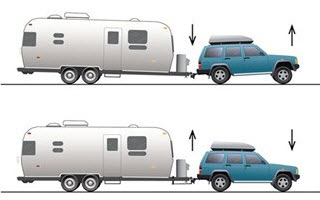Towbar Talk - Common Terms and Definitions
Choosing The Right Towbar
Common terms and definitions:
To further assist with correct operation we note some common term explanations.
Gross trailer weight (GTW)
This is the total weight of the fully loaded trailer.
The entire weight should be supported when determining the GTW. A commercial scale is the best means as found at testing and weigh-bridge stations. This method is shown in the picture to the right.
Tongue weight (TW)
Is the downward force exerted on the towball at the coupling.
For light trailers a normal bathroom scale, placed on a box to simulate the normal towbar height is suitable. If the weight is beyond the capacity of the household scale use the method pictured right and described below.
Place a household scale and block of same thickness three feet apart. Place a length of pipe on the scale and block as shown, then a beam between them. Zero the scale to account for the weight of the pipes and beam. Rest the trailer coupling on a stand on the beam one foot from the block. To obtain the tongue load multiply the result by three.
If the scales do not have the required capacity, space the block and scales four feet apart, place the trailer stand on the beam one foot from block and multiply the scale reading by four.
Note: The towbar’s tongue capability is clearly displayed on the towbar label.
Tare
Vehicle mass without fuel (As it rolls off production line)
Kerb Weight
Vehicle mass fully fuelled – lubed –without payload
GVM (Gross vehicle mass)
Vehicle fully fuelled – lubed – fully loaded with payload. (This must include the driver, but does not include a trailer)
GCM (Gross combination mass)
Gross vehicle mass (from above) plus loaded trailer.
Light vehicle
A vehicle with a GVM of less than 3500kg. Generally no COF is required although some exceptions exist e.g. PSV (passenger service vehicles)
Heavy vehicle
A vehicle whose GVM exceeds 3500kg is classed as heavy vehicle. A class one licence will allow you to drive a vehicle if the laden weight (inclusive of trailer) does not exceed 4500kg. This means a minimum of a class 2 drivers license or higher is required if the laden weight at the time of driving (inclusive of trailer and load) is 4500kg or over up to a maximum of 12000kg.
Load leveller
An accessory that attaches to the towbar and the trailer to aid in reducing sag of the vehicles rear when the trailer is attached.
Use of an effective load leveller system will provide a safer more comfortable towing experience by:
- Improving steering feel and control
- Reducing vehicle sway
- Transferring weight to front wheels for improved traction (Front wheel drive vehicles)
- Avoiding overloading of rear tyres
- Improving braking in normal and emergency
braking situations
- Fits in 1 minute (following original installation)
A correctly adjusted load leveller should return the vehicle close to its original posture with the trailer attached. (as pictured right). This is done by transfer of downforce created on the towball, back to the front wheels improving control and braking.
We have a load leveller system available for use with selected approved towbars available through Hayman Reese installers. Contact us for further detail.

Poor weight distribution (with load leveller)

Even weight distribution (with load leveller)